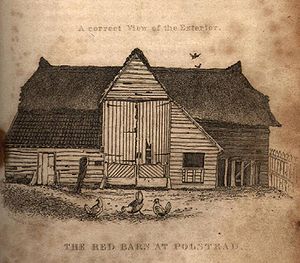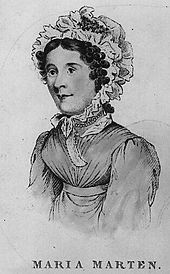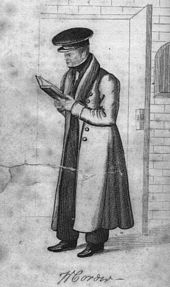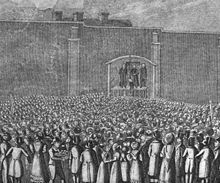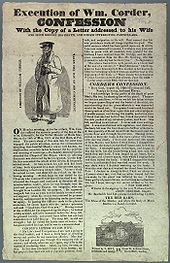- Red Barn Murder
-
For other uses, see Red Barn (disambiguation).
- Murder in the Red Barn redirects here. For the 1935 film, see Maria Marten, or The Murder in the Red Barn.
- Maria Marten redirects here. For films and plays of the same name Maria Marten (disambiguation)
The Red Barn Murder was a notorious murder committed in Polstead, Suffolk, England, in 1827. A young woman, Maria Marten, was shot dead by her lover, William Corder. The two had arranged to meet at the Red Barn, a local landmark, before eloping to Ipswich. Maria was never heard from again. Corder fled the scene and although he sent Marten's family letters claiming she was in good health, her body was later discovered buried in the barn after her stepmother spoke of having dreamt about the murder.
Corder was tracked down in London, where he had married and started a new life. He was brought back to Suffolk, and after a well-publicised trial, found guilty of murder. He was hanged in Bury St Edmunds in 1828; a huge crowd witnessed Corder's execution. The story provoked numerous articles in the newspapers, and songs and plays. The village where the crime had taken place became a tourist attraction and the barn was stripped by souvenir hunters. The plays and ballads remained popular throughout the next century and continue to be performed today.[1]
Contents
Murder
Maria Marten (born 24 July 1801) was the daughter of Thomas Marten, a molecatcher from Polstead, Suffolk.[2] In March 1826, when she was 24, she formed a relationship with the 22-year-old William Corder (born 1803). Marten was an attractive woman and relationships with men from the neighbourhood had already resulted in two children. One, the child of William's older brother Thomas, died as an infant, but the other, Thomas Henry, was still alive at the time Marten met Corder. Although Thomas Henry's father wanted nothing more to do with Marten after the birth, he occasionally sent money to provide for the child.[3]
William Corder was the son of a local farmer, and had a reputation as something of a fraudster and a ladies' man. He was known as "Foxey" at school because of his sly manner. He had fraudulently sold his father's pigs, and, although his father had settled the matter without involving the law, Corder had not changed his behaviour. He later obtained money by passing a forged cheque for £93 (£6,700 as of 2011), and he had helped a local thief, Samuel "Beauty" Smith, steal a pig from a neighbouring village. When Smith was questioned by the local constable over the theft, he made a prophetic statement concerning Corder: "I'll be damned if he will not be hung some of these days". Corder had been sent to London in disgrace after his fraudulent sale of the pigs, but he was recalled to Polstead when his brother Thomas drowned attempting to cross a frozen pond.[4] His father and three brothers all died within 18 months of each other and only William remained to run the farm with his mother.
Although Corder wished to keep his relationship with Marten secret, she gave birth to their child in 1827, at the age of 25, and was apparently keen that she and Corder should marry. The child died (later reports suggested that it may have been murdered), but Corder apparently still intended to marry Marten. That summer, in the presence of her stepmother, Ann Marten, he suggested that she meet him at the Red Barn, from where he proposed that they elope to Ipswich. Corder claimed that he had heard rumours that the parish officers were going to prosecute Maria for having bastard children. He initially suggested they elope on the Wednesday evening, but later decided to delay until the Thursday evening. On Thursday he was again delayed: his brother falling ill is mentioned as the reason in some sources, although most claim all his brothers were dead by this time. The next day, Friday, 18 May 1827, he appeared at the Martens' cottage during the day, and according to Ann Marten, told Maria that they must leave at once, as he had heard that the local constable had obtained a warrant to prosecute her (no warrant had been obtained, but it is not known if Corder was lying or was mistaken). Maria was worried that she could not leave in broad daylight, but Corder told her she should dress in men's clothing so as to avert suspicion, and he would carry her things to the barn where she could meet him and change before they continued on to Ipswich.[2]
Shortly after Corder left the house, Maria set out to meet him at the Red Barn, which was situated on Barnfield Hill, about half a mile from the Martens' cottage. This was the last time she was seen alive. Corder also disappeared, but later turned up and claimed that Marten was in Ipswich, Great Yarmouth, or some other place nearby, and that he could not yet bring her back as his wife for fear of provoking the anger of his friends and relatives. The pressure on Corder to produce his wife eventually forced him to leave the area. He wrote letters to Marten's family claiming they were married and living on the Isle of Wight, and gave various excuses for her lack of communication: she was unwell, had hurt her hand, or that the letter must have been lost.[3]
Suspicion continued to grow, and Maria's stepmother began talking of dreams that Maria had been murdered and buried in the Red Barn. On 19 April 1828 she persuaded her husband to go to the Red Barn and dig in one of the grain storage bins. He quickly uncovered the remains of his daughter buried in a sack. She was badly decomposed but still identifiable. An inquest was carried out at the Cock Inn (which still stands today) at Polstead, where Maria was formally identified, by her sister Ann, from some physical characteristics: her hair and some clothing were recognizable and a tooth she was known to be missing was also missing from the jawbone of the corpse. Evidence was uncovered to implicate Corder in the crime: his green handkerchief was discovered around the body's neck.[3]
Capture
 This "penny dreadful" from 1833 shows Maria's burial and Ayres and Lea arresting Corder.
This "penny dreadful" from 1833 shows Maria's burial and Ayres and Lea arresting Corder.
Corder was easily discovered; Mr Ayres, the constable in Polstead, was able to obtain his old address from a friend, and with the assistance of James Lea, an officer of the London police force who would later lead the investigation into Spring Heeled Jack, he tracked Corder to a ladies' boarding house, Everley Grove House, in Brentford.[4] Corder was running the boarding house with his new wife, Mary Moore, whom he had met through a newspaper advertisement that he had placed in The Times (which had received more than 100 replies).[5][6][a] Lea managed to gain entry under the pretext that he wished to board his daughter there, and surprised Corder in the parlour. Thomas Hardy noted the Dorset County Chronicle's report of his capture:[7]
…in parlour with 4 ladies at breakfast, in dressing gown & had a watch before him by which he was 'minuting' the boiling of some eggs.
Lea took him to one side and informed him of the charges; Corder denied all knowledge of both Maria and the crime. A search of the house uncovered a pair of pistols supposedly bought on the day of the murder; some letters from a Mr. Gardener, which may have contained warnings about the discovery of the crime; and a passport from the French Ambassador, evidence which suggested Corder may have been preparing to flee.[3]
Trial
Corder was taken back to Suffolk where he was tried at Shire Hall, Bury St. Edmunds. The trial started on 7 August 1828, having been put back several days because of the interest the case had generated. The hotels in Bury St. Edmunds began to fill up from as early as 21 July and, because of the large numbers that wanted to view the trial, admittance to the court was by ticket only. Despite this the judge and court officials still had to push their way bodily through the crowds that had gathered around the door to gain entry to the court room.
The judge, Chief Baron Alexander, was unhappy with the coverage given to the case by the press "to the manifest detriment of the prisoner at the bar".[8] The Times, nevertheless, congratulated the public for showing good sense in aligning themselves against Corder.[9]
Corder entered a plea of not guilty. The exact cause of death could not be established. It was thought that a sharp instrument, possibly Corder's short sword, had been plunged into Marten's eye socket, but this wound could also have been caused by her father's spade when he was exhuming the body. Strangulation could not be ruled out as Corder's handkerchief had been discovered around her neck, and, to add to the confusion, the wounds to her body suggested she had been shot. The indictment charged Corder with "…murdering Maria Marten, by feloniously and wilfully shooting her with a pistol through the body, and likewise stabbing her with a dagger."[2] To avoid any chance of a mistrial, he was indicted on nine charges, including one of forgery.
Ann Marten was called to give evidence of the events of the day of Maria's disappearance and her later dreams. Thomas Marten then told the court how he had dug up his daughter, and George Marten, Maria's 10-year-old brother, revealed that he had seen Corder with a loaded pistol before the alleged murder and later had seen him walking from the barn with a pickaxe. Lea gave evidence concerning Corder's arrest and the objects found during the search of his house.[10] The prosecution suggested that Corder had never wanted to marry Maria, but that her knowledge of some of his criminal dealings had given her a hold over him, and that his theft previously of the money sent by her child's father had been a source of tension between them.[11]
Corder then gave his own version of the events. He admitted to being in the barn with Maria but said he had left after they argued. He claimed that while he was walking away he heard a pistol shot and running back to the barn found Maria dead with one of his pistols beside her. He pleaded with the jury to give him the benefit of the doubt, but after they retired it took them only 35 minutes to return with a guilty verdict.[10] Baron Alexander sentenced him to hang and afterwards be dissected:
That you be taken back to the prison from whence you came, and that you be taken from thence, on Monday next, to a place of Execution, and that you there be hanged by the Neck until you are Dead; and that your body shall afterwards be dissected and anatomized; and may the Lord God Almighty, of his infinite goodness, have mercy on your soul!
Corder spent the next three days in prison agonising over whether to confess to the crime and make a clean breast of his sins before God. After several meetings with the prison chaplain, entreaties from his wife, and pleas from both his warder and John Orridge, the governor of the prison, he finally confessed.[12] He strongly denied stabbing Maria, claiming instead he had accidentally shot her in the eye after they argued while she was changing out of her disguise.[3]
Execution and dissection
On 11 August 1828 Corder was taken to the gallows in Bury St. Edmunds, apparently too weak to stand without support.[13] He was hanged shortly before noon in front of a huge crowd; one newspaper claimed there were 7,000 spectators, another as many as 20,000.[14] At the prompting of the prison governor, just before the hood was drawn over his head he weakly asserted:[15]
I am guilty - my sentence is just - I deserve my fate - and may God have mercy on my soul.
After an hour his body was cut down by John Foxton, the hangman, who, according to his rights, claimed Corder's trousers and stockings. The body was taken back to the courtroom at Shire Hall where it was slit open along the abdomen to expose the muscles. The crowds were allowed to file past until six o'clock when the doors were shut. According to the Norwich and Bury Post, over 5,000 people queued to see the body.[16]
The following day the dissection and post-mortem were carried out in front of an audience of students from Cambridge University and physicians. A battery was attached to Corder's limbs to demonstrate the contraction of the muscles, the sternum was opened and the internal organs examined. There was some discussion as to whether the cause of death was suffocation, but since it was reported that Corder's chest was seen to rise and fall for several minutes after he had dropped, it was thought probable that pressure on the spinal cord had killed him. Since the skeleton was to be reassembled after the dissection, it was not possible to examine the brain, so instead the surgeons contented themselves with a phrenological examination of the skull. Corder's skull was asserted to be profoundly developed in the areas of "secretiveness, acquisitiveness, destructiveness, philoprogenitiveness, and imitativeness" with little evidence of "benevolence or veneration". The bust of Corder held by Moyse's Hall Museum in Bury St. Edmunds is an original made by Child of Bungay, Suffolk, as a tool for the study of Corder's phrenology. The skeleton was reassembled, exhibited and used as a teaching aid in the West Suffolk Hospital.[17] Several copies of his death mask were made, a replica of one is held at Moyse's Hall Museum. Artifacts from the trial and some which were in Corder's possession are also held at the museum.[18] Corder's skin was tanned by the surgeon George Creed, and used to bind an account of the murder.[b]
Corder's skeleton was put on display in the Hunterian Museum in the Royal College of Surgeons of England, where it hung beside that of Jonathan Wild. In 2004, Corder's bones were removed from display and cremated.[19]
Rumours
After the trial, doubts were raised about both the story of the stepmother's dreams and the fate of Maria and William's child. The stepmother was only a year older than Maria, and it was suggested that she and Corder had been having an affair, and the two had planned the murder to dispose of Maria so that it could continue without hindrance. Since her dreams had started only a few days after Corder married Moore, it was suggested that jealousy was the motive for revealing the body's resting place and that the dreams were a simple subterfuge.[3]
Further rumours circulated about the death of Corder and Marten's child. Both claimed that they had taken their dead child to be buried in Sudbury, but no records of this could be discovered and no trace of the burial site of the child was ever found.[3] In his written confession Corder admitted that on the day of the murder he and Marten had argued over the possibility of the burial site being discovered.
In the 20th Century a new set of rumours appeared when the writer and researcher Donald McCormick wrote The Red Barn Mystery. He brought out some interesting points, including a hitherto unknown connection between Corder and the forger and poisoner Thomas Griffiths Wainewright when Corder was in London, and that an actress Caroline Palmer, who was appearing frequently in the melodrama based on the case and researching the murder, concluded that Corder may have not killed Maria and that a local gypsy woman might have been the killer. However, McCormick's research on other police related and crime related stories has been brought into question and this information has not been generally accepted.
Popular interest
The case had all the elements to ignite a fervent popular interest: the wicked squire and the poor girl, the iconic murder scene, the supernatural element of the stepmother's prophetic dreams, the detective work by Ayres and Lea (who later became the detective Pharos Lee in stage versions of the events) and Corder's new life which was the result of a lonely hearts advertisement. As a consequence, the case created its own small industry.
Plays were being performed while Corder was still awaiting trial and, after the execution, an anonymous author published a melodramatic version of the murder—a precursor of the Newgate novels—which quickly became a best-seller. Along with the story of Jack Sheppard and other highwaymen, thieves and murderers, the Red Barn Murder was a popular subject for penny gaffs, cheap plays performed for the entertainment of the lower classes in the gin-soaked atmosphere of the back rooms of public houses.[20] After the execution, James Catnach managed to sell over a million broadsides (sensationalist single sheet newspapers).[21][c] Catnach's sheets gave details of Corder's confession and the execution, and included a sentimental ballad supposedly penned by Corder himself, but more likely to have been the work of Catnach or somebody in his employ.[22][23] It was one of at least five ballads about the crime that appeared directly following the execution.[24]
Owing to the excitement around the trial and the public demand for entertainments based on the murder, many different versions of the events were set down and distributed, making it hard for modern readers to discern fact from melodramatic embellishment. Good records of the trial exist from the official records, and the best record of the events surrounding the case is generally considered to be that of James Curtis, a journalist who spent time with Corder and two weeks in Polstead interviewing those concerned.[3] Curtis was apparently so connected with the case that when asked to produce a picture of the accused man, an artist for one of the newspapers drew him rather than Corder.[25]
Pieces of the rope which was used to hang Corder sold for a guinea each. Part of Corder's scalp with an ear still attached was displayed in a shop in Oxford Street.[26] A lock of Maria's hair sold for two guineas. Polstead became a tourist venue with visitors travelling from as far afield as Ireland;[27] Curtis estimated that 200,000 people visited Polstead in 1828 alone.[3] The Red Barn and the Martens' cottage excited particular interest.[27] The barn was stripped for souvenirs, down to the planks being removed from the sides, broken up and sold as toothpicks.[28] It was planned to be demolished after the trial, but it was left standing and eventually burnt down in 1842.[3][d] Even Maria's gravestone was eventually chipped away to nothing by souvenir hunters. Pottery models and sketches were sold and songs composed, including one mentioned in the Vaughan Williams opera Hugh the Drover.
Corder's skeleton was put on display in a glass case in the West Suffolk Hospital, and apparently rigged with a mechanism that made its arm point to the collection box when approached. Eventually, the skull was replaced by a Dr. Kilner who wanted to add Corder's skull to his extensive collection of Red Barn memorabilia. After a series of unfortunate events, Kilner became convinced the skull was cursed and handed it on to his friend Hopkins. Further disasters plagued both men and they finally paid for the skull to be given a Christian burial in an attempt to lift the supposed curse.[29]
Interest in the case did not quickly fade. Maria Marten; or The Murder in the Red Barn, which existed in various anonymous versions, was a sensational hit throughout the mid 19th century and may have been the most performed play of this time; Victorian fairground peepshows were forced to add extra apertures to their viewers when exhibiting their shows of the murder to cope with the demand.[4] The plays of the Victorian era tended to portray Corder as a cold-blooded monster and Maria as the innocent he preyed upon; her reputation and her children by other fathers were airbrushed out,[30] and Corder was made into an older man.[31] Charles Dickens published an account of the murder in his magazine All The Year Round after initially rejecting it because he felt the story to be too well known and the account of the stepmother's dreams rather far-fetched.[32]
Although diminished, the fascination continued into the 20th century with five film versions, including the 1935 Maria Marten or Murder in the Red Barn,[31] starring Tod Slaughter, which was only released in the US after some scenes were cut,[e] and a 1980 BBC drama, Maria Marten, with Pippa Guard in the title role. A fictionalized account of the murder was produced in 1953 for the CBS radio series "Crime Classics".[33] The incident has inspired a number of contemporary musicians: No Roses by the Albion Country Band, released in 1971, included the traditional song "Murder of Maria Martin"; more recently, "Murder in the Red Barn", a song by Tom Waits (co-written with his wife Kathleen Brennan) from his 1992 album Bone Machine,[34] and Kathryn Roberts and Sean Lakeman's "The Red Barn" on the 2004 album 2 have referred to the event. The song "Maria Martin" included on the folk album White Swans Black Ravens was recorded live in Moyse's Hall Museum. In 1991, a melodramatic stage version, with some political and folk-tale elements, was written by Christopher Bond, whose first melodrama, Sweeney Todd, inspired Stephen Sondheim to write his musical version.
Notes
a. ^ Moore's first name is occasionally reported as Maria but an inscription in Corder's journal and later reports make it clear she was called Mary. The initial newspaper reports said that she had seen Corder's advertisement in a pastry shop window. Whether this is true or not is unknown, but Corder had certainly received replies for his advertisement in The Times, a number of which can be found in Curtis' account of the case.
b. ^ The account of the case bound in Corder's tanned skin is held at Moyse's Hall Museum and contains a hand-written account of a witticism on the inside cover: on the night of the execution, during a performance of Macbeth at Drury Lane, when the line "Is execution done on Cawdor?" was spoken, a man shouted from the gallery "Yes! - He was hung this morning at Bury"
c. ^ Accounts of how many were sold vary but are consistently quoted as either 1,160,000 or 1,600,000. Catnach claimed it had sold over 1,650,000.[35]
d. ^ In November 2007 a report of a fire that nearly destroyed Marten's cottage was on the front page of the East Anglian Daily Times. Firefighters saved 80% of the thatched roof at Marten's former home after a chimney fire threatened the "iconic Suffolk cottage", now run as a bed and breakfast.[36]
e. ^ In Britain the script was submitted to the British Board of Film Censors who passed it on the condition that the execution scene was cut. The scene was filmed anyway, but the Board demanded it be removed before the film was passed.[31] In the U.S., scenes emphasising Maria's pregnancy, and featuring the words slut and wench were cut, and the scene of her burial shortened. Virginia and Ohio made further cuts to the versions they approved for distribution.[37]
Citations
- ^ "Maria Martin". The Crushed Tragedian. http://thecrushedtragedian.blogspot.com/2010/03/maria-marten-or-murder-in-red-barn.html. Retrieved 11 August 2010.
- ^ a b c Smith, John Hay (1847). Celebrated Trials of All Countries, and Remarkable Cases of Criminal Jurisprudence. J.Harding. http://books.google.com/?id=pj3FyXaS91YC&printsec=toc.
- ^ a b c d e f g h i j "The Red Barn Murder". St Edmundsbury Council. http://www.stedmundsbury.gov.uk/sebc/visit/redbarn-intro.cfm. Retrieved 15 February 2007.
- ^ a b c Brewers p.168–9
- ^ Maclaren p.250
- ^ Urban, Sylvanus (1857). "Obituary". The Gentleman's Magazine (London: John Henry and James Parker) 3 (203).
- ^ Hardy p.131 Note 85.b
- ^ The Times 9 August 1828 p.3 quoted in Wiener p.138
- ^ The Times 12 August 1828 p.3 quoted in Wiener p.138
- ^ a b Urban, Sylvanus (1828). "Domestic Occurrences". The Gentleman's Magazine (London: J.B Nichols) 98 (21). http://books.google.com/?id=Lz7AQhG2eWkC.
- ^ Cairns p.40
- ^ Langbein p.270
- ^ Gatrell p.13
- ^ Gatrell p.32
- ^ Cairns p.18
- ^ Curtis p.210
- ^ Gatrell pp.256–7
- ^ "Local History of Moyse's Hall". St. Edmundsbury Borough Council. http://www.stedmundsbury.gov.uk/sebc/visit/moyses-local-history.cfm. Retrieved 4 July 2007.
- ^ "Killer cremated after 180 years". BBC News. 17 August 2004. http://news.bbc.co.uk/1/hi/england/suffolk/3573244.stm. Retrieved 4 July 2007.
- ^ Picard p.198
- ^ Gatrell p.159
- ^ Neuberg p.138
- ^ Hindley p.79
- ^ Pettitt, Tom (2005-05). "The Murdered Sweetheart: Child of Print and Panic?" (PDF). Massachusetts Institute of Technology. http://web.mit.edu/comm-forum/mit4/papers/Pettitt.pdf. Retrieved 12 February 2007.
- ^ Caulfield p.55
- ^ Gatrell p.258
- ^ a b Mackay p.700
- ^ Gatrell p.43
- ^ Storey p.118
- ^ Wiener pp. 138–9
- ^ a b c Richards p.136
- ^ Letters of Charles Dickens p.371
- ^ "Premier Collections: Crime Classics". First Generation Radio Archives. 2007. http://www.radioarchives.org/sets/PC19.htm. Retrieved 24 November 2007.
- ^ "ask lyrics". asklyrics.com. 2008. http://www.asklyrics.com/display/Tom_Waits/Murder_in_The_Red_Barn_Lyrics/184224.htm. Retrieved 22 November 2008.
- ^ "Broadside Ballads and the Oral Tradition". University of Glasgow. Archived from the original on October 10, 2006. http://web.archive.org/web/20061010053032/http://www.cc.gla.ac.uk/courses/scottish/ballads/introduction_broadside_ballads_.htm. Retrieved 16 February 2007.
- ^ Claydon, Russell (27 November 2007). "Blaze at home of famous murder victim". East Anglian Daily Times. http://www.eadt.co.uk/content/eadt/news/story.aspx?brand=EADOnline&category=News&tBrand=EADOnline&tCategory=news&itemid=IPED26%20Nov%202007%2023%3A25%3A30%3A853. Retrieved 2007-11-27.
- ^ Slide p.103
References
- Brown, Margaret (Ed.) (1999). The Letters of Charles Dickens: 1865–1867 Vol 11. Clarendon Press. p. 598. ISBN 0198122950.
- Cairns, David (1999). Advocacy and the Making of the Adversarial Criminal Trial 1800–1865 (Oxford Studies in Modern Legal History). Clarendon Press. p. 230. ISBN 0198262841.
- Caulfield, Catherine (2005). The Man Who Ate Bluebottles: And Other Great British Eccentrics. Icon Books Ltd. p. 224. ISBN 1840466979.
- Church, Robert (1990). More murders in East Anglia. Robert Hale. pp. 11–28. ISBN 0-7090-4031-6.
- Curtis, James (1828). The Mysterious Murder of Maria Marten. London: William Clowes.
- Donaldson, Willie (2004). Brewer's Rogues, Villains and Eccentrics. Phoenix Press. p. 736. ISBN 0753817918.
- Gatrell, V. A. C. (1996). The Hanging Tree: Execution and the English People, 1770–1868. Oxford Paperbacks. p. 654. ISBN 0-19-285332-5.
- Hardy, Thomas (2004). Greenslade, William. ed. Thomas Hardy's 'Facts' Notebook. Ashgate Publishing, Ltd.. p. 365. ISBN 1840142359.
- Hindley, Charles (1969) [1869]. The History of the Catnach Press. Detroit: Singing Tree Press.
- Langbein, John H. (2003). The Origins of Adversary Criminal Trial (Oxford Studies in Modern Legal History). Oxford University Press. p. 376. ISBN 0199258880.
- Mackay, Charles (1995). Extraordinary Popular Delusions and the Madness of Crowds. Wordsworth Editions Ltd. p. 748. ISBN 1853263494.
- Maclaren, Angus (1997). The Trials of Masculinity: policing sexual boundaries, 1870–1930. University of Chicago Press. p. 307. ISBN 0226500675.
- McCormick, Donald (1968). The Red Barn Mystery: some new evidence on an old murder. A.S.Barnes and Co.. p. 206.
- Neuburg, Victor (1977). Popular Literature: A History and Guide. Routledge. p. 302. ISBN 0713001585.
- Picard, Liza (2006). Victorian London: The Tale of a City 1840—1870. St. Martin's Press. p. 384. ISBN 0312325673.
- Richards, Jeffrey (Ed.) (2001). The Unknown 1930s: An Alternative History of the British Cinema 1929–1939. I B Tauris & Co Ltd. p. 287. ISBN 186064628X.
- Slide, Anthony (1998). Banned in the U.S.A.: British Films in the United States and their Censorship, 1933–1966. I. B. Tauris. p. 232. ISBN 1860642543.
- Storey, Neil R. (2004). A Grim Almanac of Suffolk. Sutton Publishing. p. 192. ISBN 0750934980.
- Wiener, Martin J. (2004). Men of Blood: Violence, Manliness, and Criminal Justice in Victorian England. Cambridge University Press. p. 312. ISBN 0521831989.
- "The Red Barn Murder". St Edmundsbury Council. http://www.stedmundsbury.gov.uk/sebc/visit/redbarn-intro.cfm. Retrieved 13 November 2006.
- "Victorian Murder at the Red Barn - Polstead - Suffolk". Suffolk Coast. http://www.norfolkcoast.co.uk/pasttimes/pt_murderredbarn.htm. Retrieved 13 November 2006.
Categories:- 1827 crimes
- 1828 in England
- 19th-century executions by the United Kingdom
- History of Suffolk
- Murder in England
- Murders
Wikimedia Foundation. 2010.

